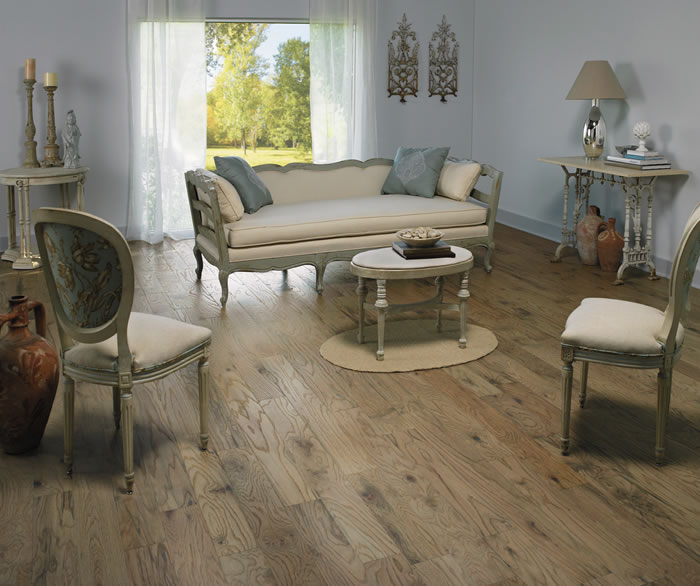Hardwood Flooring Must-Know Shopping Facts
With so many available options for hardwood flooring, today’s busy and environmentally responsible consumer wants information – accurate information – to simplify the process of selecting a new hardwood floor.
Be a knowledgeable consumer and get the facts about U.S. hardwoods. They are “green,” exceptionally beautiful and can last a lifetime.” Here are some of the things you’ll want to know to make the right choice for hardwood flooring.

Photo courtesy of Columbia Flooring
Know the Facts and Shop with Confidence
- A solid hardwood floor will provide decades of extraordinary beauty, durable service and flexibility. Remember, solid hardwood flooring can be refinished for changing tastes or excessive wear. It may initially cost a little more, but as trends evolve, it can too.
- Hardwood floors are non-toxic and trap no allergens such as mold spores and dust. Simple maintenance – dust mopping, sweeping or vacuuming – will keep hardwood floors looking great and allergen-free.
- U.S. hardwoods are truly sustainable. The US Forest Service, in a 2008 report, verified that the average annual net growth for hardwoods is greater than average annual removals. The volume of hardwood timberland in American forests is almost double that of 50 years ago.
- U.S. hardwoods are an all-natural, carbon-negative material. They have no emissions for methane, nitrogen oxides and other particulate matter and they are homegrown. Being regionally sourced further minimizes their carbon footprint.
- When considering a particular U.S. hardwood species, pay attention to its hardness rating scale, referred to as the Janka Scale. For high traffic areas, consider Oak, Maple, Cherry and Ash, species with higher hardness ratings.
Which one?
Pre-finished solid hardwood flooring is just that – already sanded and sealed, by the manufacturer, with at least four coats of ultraviolet-cured urethane resin. It offers consistent quality, quicker installation and immediate gratification, meaning you can walk on it as soon as it is laid. Time and money saved during the installation typically off-set the initial higher material cost.
Unfinished solid hardwood flooring must be sanded and sealed on-site. While it does offer more color choices, it requires extensive preparation. The sanding process is messy; significant drying time is required after each sealing application requiring up to five days for completion. While the initial material cost is lower, remember the additional finishing cost.
Engineered flooring, consisting of a plywood base that’s covered with a 1/16 to 1/8 inch thick layer of wood, works well in bathrooms and basements where light moisture might be a concern. It is almost always pre-finished. Because the top layer is so thin, it can’t be sanded more than one to three times and usually requires a professional to do it. Keep in mind that the less expensive choices cannot be sanded at all due to the very thin top layer.
Don’t be Misled by Lookalikes
The least expensive flooring option is laminate. It looks like wood, but it’s really a printed paper that is affixed to a wood-chip base or high-density fiberboard, covered with a clear surface layer to absorb daily impact. Its issue is that it can’t be repaired or sanded when scratches or dings occur.
Tropical woods, not native to the U.S., are being renamed and falsely marketed as favorite hardwoods. Be careful. Brazilian Cherry is jatoba and Chilean Cherry is lenga. Neither is Cherry. Tasmanian Oak and Australian Heritage Oak are eucalyptus, not Oak. Malaysian Oak is rubber wood and Australian Cypress is pine. When in doubt, review the U.S. Hardwood Species Guide on this website.
Bamboo flooring is being called hardwood. It is not. Bamboo is a grass grown typically in tropical regions of the world and it is not carbon negative. To make flooring, the grass is glued together under tremendous pressures of up to 1,200 pounds per square inch. Glue content can range from three to 20 percent, and often contains urea formaldehyde, which is classified as a probable human carcinogen. Manufacturers approximate it could last only 30 years. And because it is typically manufactured in Southeast Asia, shipment to U.S. shores increases its carbon footprint, significantly. (Additional information.)
As you contemplate your home improvement projects, make choices based upon the facts, not hype. Choose nature’s quintessential “green” material, U.S. hardwood, for flooring, furniture, mouldings, millwork and cabinetry that will last.



